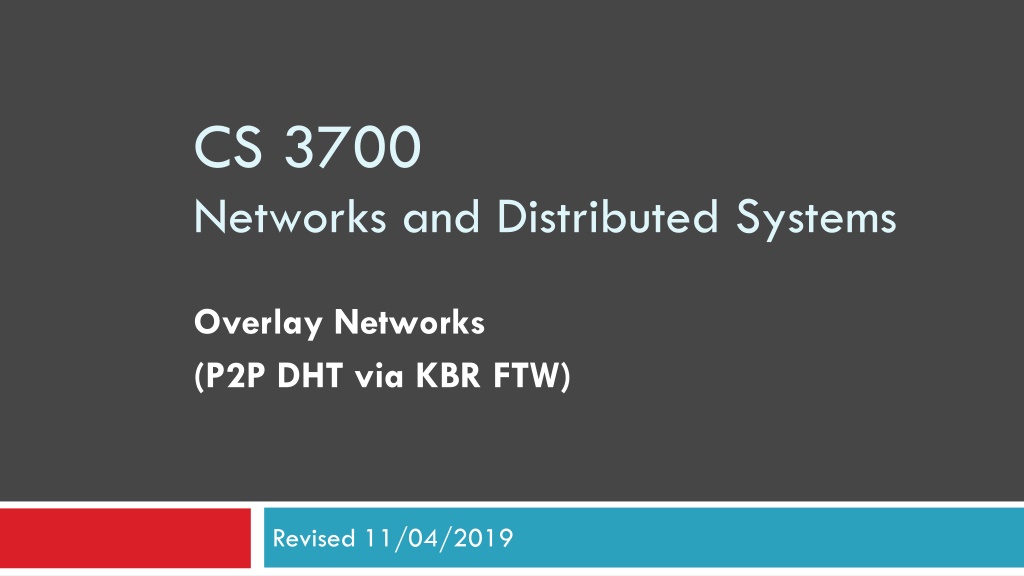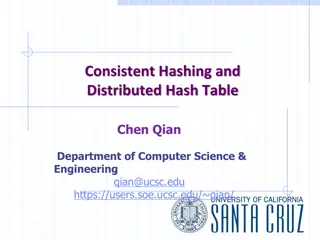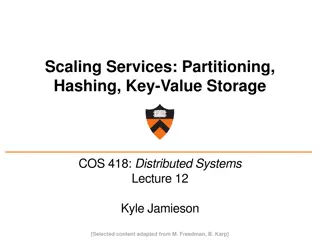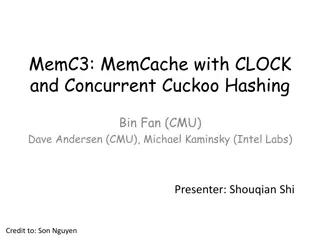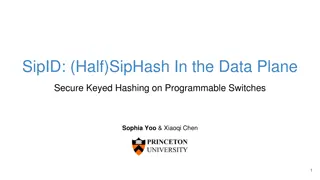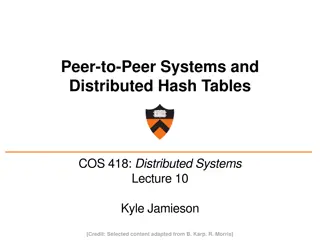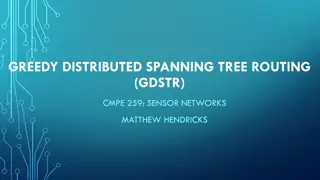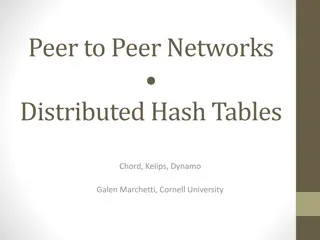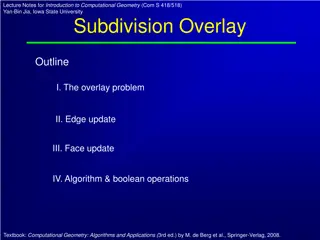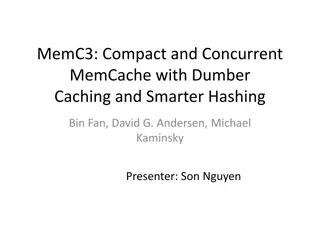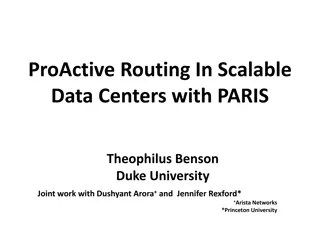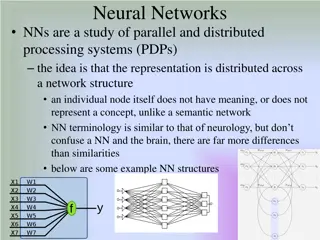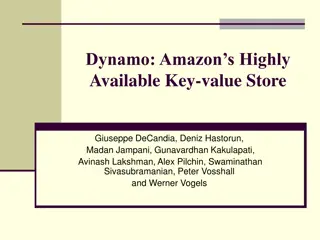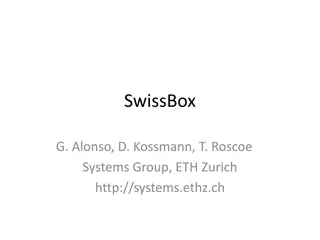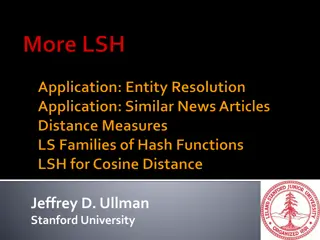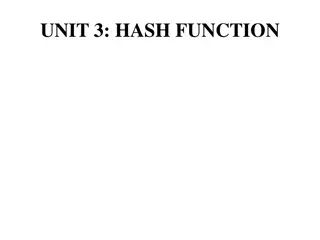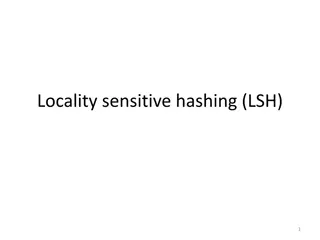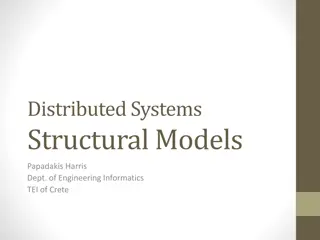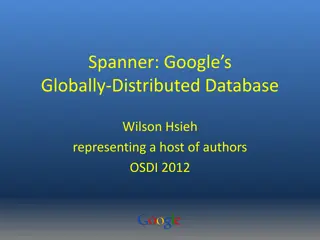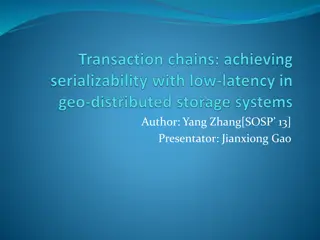Overlay Networks and Consistent Hashing in Distributed Systems
Understanding the concept of overlay networks and consistent hashing in distributed systems is crucial for scalability and efficient data storage. Overlay networks like P2P DHT via KBR offer a decentralized approach for managing data while consistent hashing provides a balanced and deterministic way to map keys to servers, ensuring minimal data movement during server changes. This approach enables scalable key/value storage services and efficient mapping of keys to servers in dynamic environments.
Download Presentation

Please find below an Image/Link to download the presentation.
The content on the website is provided AS IS for your information and personal use only. It may not be sold, licensed, or shared on other websites without obtaining consent from the author. Download presentation by click this link. If you encounter any issues during the download, it is possible that the publisher has removed the file from their server.
E N D
Presentation Transcript
CS 3700 Networks and Distributed Systems Overlay Networks (P2P DHT via KBR FTW) Revised 11/04/2019
Outline 2 Consistent Hashing Structured Overlays / DHTs
Key/Value Storage Service 3 Imagine a simple service that stores key/value pairs Similar to memcached or redis put( ajackson , abc ) get( ajackson ) abc One server is probably fine as long as total pairs < 1M How do we scale the service as pairs grows? Add more servers and distribute the data across them
Mapping Keys to Servers 4 Problem: how do you map keys to servers? Keep in mind, the number of servers may change (e.g. we could add a new server, or a server could crash) ? < key1 , value1 > < key2 , value2 > < key3 , value3 >
Hash Tables 5 Array (length = n) < key2 , value2 > < key1 , value1 > hash(key) % n array index < key2 , value2 > < key3 , value3 > < key1 , value1 > < key3 , value3 >
(Bad) Distributed Key/Value Service 6 k2 Array A (length = n) (length = n + 1) IP address of node A < key1 , value1 > B IP address of node B hash(str) % n array index < key2 , value2 > IP address of node C k3 C IP address of node D < key3 , value3 > IP address of node E k1 D Number of servers (n) will change Need a deterministic mapping As few changes as possible when machines join/leave E
Consistent Hashing 7 Alternative hashing algorithm with many beneficial characteristics Deterministic (just like normal hashing algorithms) Balanced: given n servers, each server should get roughly 1/n keys Locality sensitive: if a server is added, only 1/(n+1) keys need to be moved 1. 2. 3. Conceptually simple Imagine a circular number line from 0 1 Hash the ID of each server and place it on the number line Hash each key and place it at the next server on the number line Move around the circle clockwise to find the next server
Consistent Hashing Example 8 k2 server A A server B 1 0 server C k2 B server D A C (hash(str) % 256)/256 ring location server E k3 C k1 k3 < key1 , value1 > B k1 < key2 , value2 > E D < key3 , value3 > D E
Practical Implementation 9 In practice, no need to implement complicated number lines Store a list of servers, sorted by their hash (floats from 0 1) To put() or get() a pair, hash the key and search through the list for the first server where hash(server) >= hash(key) O(log n) search time if we use a sorted data structure like a heap O(log n) time to insert a new server into the list
Improvements to Consistent Hashing 10 Problem: hashing may not result in perfect balance (1/n items per server) Solution: balance the load by hashing each server multiple times 1 0 B A A B consistent_hash( serverA_1 ) = consistent_hash( serverA_2 ) = consistent_hash( serverA_3 ) = B A 1 0 Problem: if a server fails, data may be lost Solution: replicate keys/value pairs on multiple servers B k1 A consistent_hash( key1 ) = 0.4
Consistent Hashing Summary 11 Consistent hashing is a simple, powerful tool for building distributed systems Provides consistent, deterministic mapping between names and servers Often called locality sensitive hashing Ideal algorithm for systems that need to scale up or down gracefully Many, many systems use consistent hashing CDNs Databases: memcached, redis, Voldemort, Dynamo, Cassandra, etc. Overlay networks (more on this coming up )
Outline 12 Consistent Hashing Structured Overlays / DHTs
Layering, Revisited 13 Layering hides low level details from higher layers IP is a logical, point-to-point overlay Host 1 Host 2 Router Application Transport Network Data Link Physical Application Transport Network Data Link Physical Network Data Link Physical
Towards Network Overlays 14 IP provides best-effort, point-to-point datagram service Maybe you want additional features not supported by IP or even TCP Multicast Security Reliable, performance-based routing Content addressing, reliable data storage Idea: overlay an additional routing layer on top of IP that adds additional features
Example: Virtual Private Network (VPN) 15 Private Public Private 34.67.0.1 34.67.0.3 VPN is an IP over IP overlay Not all overlays need to be IP-based 74.11.0.1 74.11.0.2 Internet 34.67.0.4 34.67.0.2 Dest: 74.11.0.2 Dest: 34.67.0.4 VPNs encapsulate IP packets over an IP network
Network Overlays 16 Host 1 Host 2 Router Application Application P2P Overlay P2P Overlay Transport Transport VPN Network VPN Network Network Network Network Data Link Data Link Data Link Physical Physical Physical
Network Layer, version 2? 17 Function: Provide natural, resilient routes based on keys Enable new classes of P2P applications Application Network Key challenge: Routing table overhead Performance penalty vs. IP Transport Network Data Link Physical
Unstructured P2P Review 18 Redundancy What if the file is rare or far away? Search is broken High overhead No guarantee it will work Traffic Overhead
Why Do We Need Structure? 19 Without structure, it is difficult to search Any file can be on any machine Centralization can solve this (i.e. Napster), but we know how that ends How do you build a P2P network with structure? Give every machine and object a unique name Map from objects machines Looking for object A? Map(A) X, talk to machine X Looking for object B? Map(B) Y, talk to machine Y 1. 2. Is this starting to sound familiar?
Nave Overlay Network 20 P2P file-sharing network Problems? 1 0 Peers choose random IDs How do you know the IP addresses of arbitrary peers? There may be millions of peers Peers come and go at random (churn) Locate files by hashing their names 0.322 GoT_s03e04.mkv hash( GoT ) = 0.314
Structured Overlay Fundamentals 21 Every machine chooses a unique, random ID Used for routing and object location, instead of IP addresses Deterministic Key Node mapping Consistent hashing Allows peer rendezvous using a common name Advantages Completely decentralized Self organizing Infinitely scalable Key-based routing Scalable to any network of size N Each node needs to know the IP of b*logb(N) other nodes Much better scalability than OSPF/RIP/BGP Routing from node A B takes at most logb(N) hops
Structured Overlays at 10,000ft. 22 Node IDs and keys from a randomized namespace Incrementally route towards to destination ID Each node knows a small number of IDs + IPs ABCE Each node has a routing table ABC0 Forward to the longest prefix match To: ABCD AB5F A930
Details 24 Structured overlay APIs route(key, msg) : route msg to node responsible for key Just like sending a packet to an IP address Distributed hash table (DHT) functionality put(key, value) : store value at node/key get(key) : retrieve stored value for key at node Key questions: Node ID space, what does it represent? How do you route within the ID space? How big are the routing tables? How many hops to a destination (in the worst case)?
Tapestry/Pastry 25 Node IDs are numbers in a ring 160-bit circular ID space 1111 | 0 To: 1110 Node IDs chosen at random 0 Messages for key X is routed to live node with longest prefix match to X Incremental prefix routing 1110: 1XXX 11XX 111X 1110 1110 0010 0100 1100 1010 0110 1000
Physical and Virtual Routing 26 1111 | 0 To: 1110 0 1111 1110 0010 To: 1110 0100 1100 0010 1100 1010 0110 1000 1010
Problem: Routing Table Size 27 Definitions: N is the size of the network b is the base of the node IDs d is the number of digits in node IDs bd = N If N is large, then a na ve routing table is going to be huge Assume a flat naming space (kind of like MAC addresses) A client knows its own ID To send to any other node, would need to know N-1 other IP addresses Suppose N = 1 billion :(
Tapestry/Pastry Routing Tables 28 Incremental prefix routing Definitions: N is the size of the network b is the base of the node IDs d is the number of digits in node IDs bd = N How many neighbors at each prefix digit? b-1 How big is the routing table? Total size: b * d Or, equivalently: b * logb N logb N hops to any destination 1111 | 0 1110 0 0011 1110 0010 0100 1100 1011 1010 0110 1000 1010 1000
Derivation 29 Definitions: N is the size of the network b is the base of the node IDs d is the number of digits in node IDs bd = N bd can enumerate up to N items Routing table size is b * d bd = N d * log b = log N d = log N / log b d = logb N Key result! Size of routing tables grows logarithmically to the size of the network Huge P2P overlays are totally feasible Thus, routing table is size b * logb N
Routing Table Example 30 Hexadecimal (base-16), node ID = 65a1fc4 Each x is the IP address of a peer Row 0 Row 1 d Rows (d = length of node ID) Row 2 Row 3
Routing, One More Time 31 Each node has a routing table 1111 | 0 Routing table size: b * d or b * logb N Hops to any destination: logb N To: 1110 0 1110 0010 0100 1100 1010 0110 1000
Leaf Sets 32 Each node has an additional table of the L/2 numerically closest neighbors Larger and smaller Uses Alternate routes Fault detection (keep-alive) Replication of data
Joining the Overlay 33 Pick a new ID X Contact an arbitrary bootstrap node Route a message to X, discover the current owner Add new node to the ring Download routes from new neighbors, update leaf sets 1. 1111 | 0 2. 0 1110 0010 3. 0100 1100 4. 5. 1010 0110 0011 1000
Node Departure 34 Leaf set members exchange periodic keep-alive messages Handles local failures Leaf set repair: Request the leaf set from the farthest node in the set Routing table repair: Get table from peers in row 0, then row 1, Periodic, lazy
DHTs and Consistent Hashing 35 Mappings are deterministic in consistent hashing Nodes can leave Nodes can enter Most data does not move 1111 | 0 To: 1101 0 1110 0010 Only local changes impact data placement Data is replicated among the leaf set 0100 1100 1010 0110 1000
Structured Overlay Advantages and Uses 38 High level advantages Complete decentralized Self-organizing Scalable and (relatively) robust Applications Reliable distributed storage OceanStore (FAST 03), Mnemosyne (IPTPS 02) Resilient anonymous communication Cashmere (NSDI 05) Consistent state management Dynamo (SOSP 07) Many, many others Multicast, spam filtering, reliable routing, email services, even distributed mutexes
Trackerless BitTorrent 39 Torrent Hash: 1101 Tracker 1111 | 0 Leecher 0 Tracker 1110 0010 Initial Seed 0100 1100 Swarm 1010 0110 Leecher Initial Seed 1000
